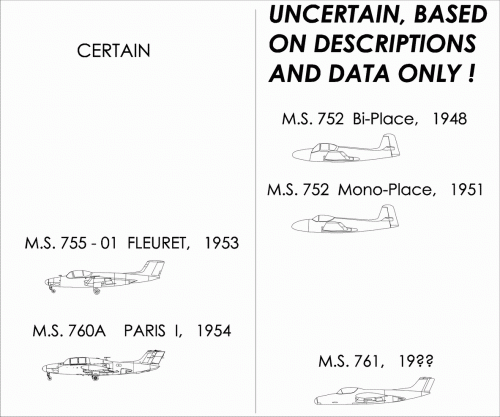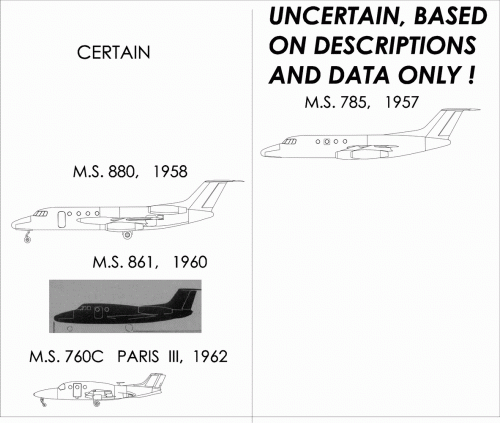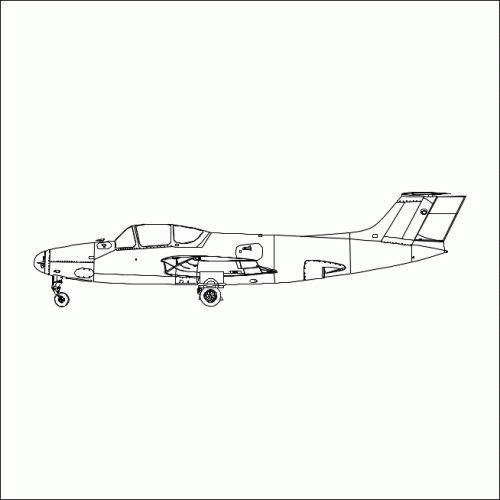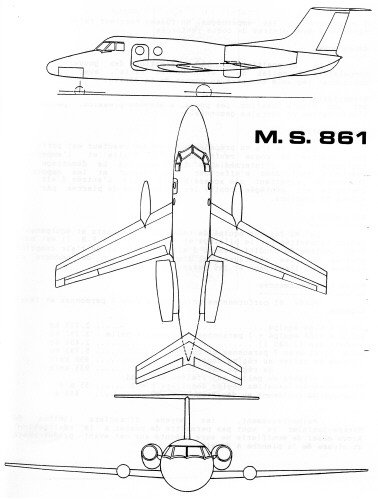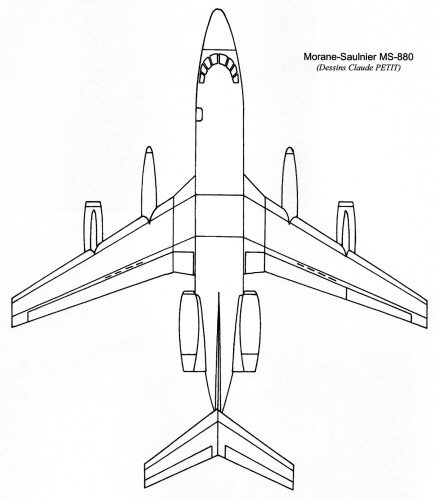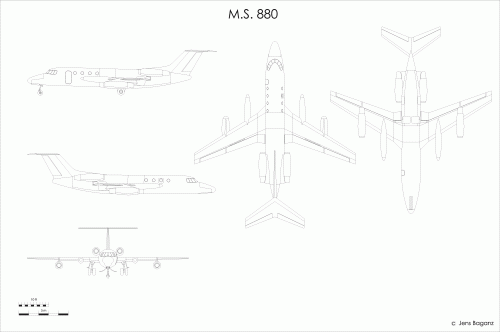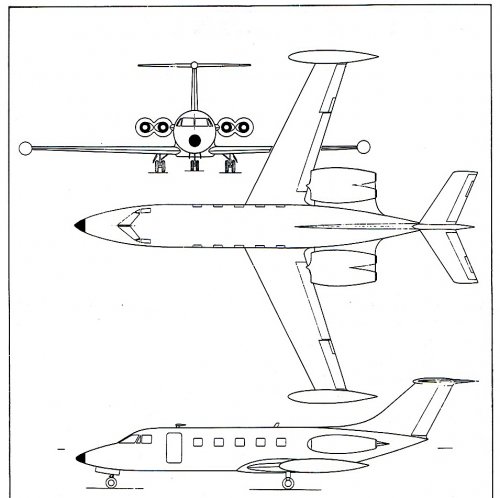- Joined
- 11 March 2006
- Messages
- 8,625
- Reaction score
- 3,805
And again I’m trying to find more informations about one of my all-time favourites :
Morane-Saulnier, and this time, I’m working on the line of jet trainer aircraft, that led
in the end to bizz jets/private jets, quite a number are still flying today.Most important
source, as usual was Jean Cuny and his bible, called „Les Avions De Combat Francais“,
but many questions reman open. The following drawings on the left hand side can be
taken for certain, as they are based at least on drawings, which were shown in serious
and trustable sources, but, ATTENTION, all drawings on the RIGHT hand side are just
based on data and descriptions, so they are ABSOLUTELY UNCERTAIN !
These are the missing links in this line of designs and I really hope, that someone of you
will remember, seeing one of them in an old magazine on the attic, or on your friends HD,
or, maybe in your grandmas cookery book. If so, please, please, walk up the stairs, ask
your friend, or visit your granny again !
___________________________________________________________________________
In 1948 Morane began the development of a twin engined jet trainer with two Turboméca
Marborè II engines. This design was at least partially based on the MS.733 Alcyon and
carried the designation MS.752. In 1951 a single seat attack derivative was proposed,
retaining the same designation (strange, regarding the standard desigantion scheme).
These designs didn’t come to fruition, but led to the MS.755 „Fleuret“ in 1953, the contender
or an advanced jet trainer, the contest evenually won by the Fouga Magister. Although not
a direct success, the MS.755 was used as the changed into a four-seat fast communications
aircraft, the MS.760, first flown in 1954.In this form it achieved reasonable success with the
AdlA, some foreign airforces (Brazil and Argentina) and later even on the civil market (refurbished
aircraft). The south american examples could be used as armed trainers/light attack aircraft, but
a dedicated attack variant was proposed, too, probably designated MS.761, which would have
been armed with fixed heavy machine guns in the nose and an internal weapons bay. Interestingly
the navigator/gunner had a prone position in the nose. The MS.760 was developed into the MS.760C
Paris III, a five/six seat fast transport, nowadays falling into the „bizzjet“ category. This type was
finished in 1962, first flown in 1963, but development seems to have started several years before.
In 1957 on the Aerosalon in Le Bourget, the MS.785 was revealed, a much larger design with 4 Marborè
engines podded under the wing, for eight passengers, but still bearing several similarities with the
MS.760. Around 1958 this design was changed into the MS.880 (not to be confused with the later
single engine MS.880 Rally !), with two engines moved to the tail, à la Caravelle and two Palouste
engines buried in the tail were added, to provide bleed air for the blown flaps, to secure exceptional
short-field performances. Would have been the worlds first and probably still yet only six engined
bizz jet ad some time later it became clear, that there was no market for such an aircraft, as this
would have been quite an expensive way to move around 8 people ! So this project died, too, but in
1960, the MS.861 was proposed, especially aimed at the US market, a kind of enlarged Paris III, but
obviously not proceeded with any further (sorry, still yet, I've no self-made drawin, so I used the
one from Aviation Week May 1960). In 1963 Morane-Saulnier merged with Potez, so ending the
line of indigenous Morane-Saulnier aircraft.
Morane-Saulnier, and this time, I’m working on the line of jet trainer aircraft, that led
in the end to bizz jets/private jets, quite a number are still flying today.Most important
source, as usual was Jean Cuny and his bible, called „Les Avions De Combat Francais“,
but many questions reman open. The following drawings on the left hand side can be
taken for certain, as they are based at least on drawings, which were shown in serious
and trustable sources, but, ATTENTION, all drawings on the RIGHT hand side are just
based on data and descriptions, so they are ABSOLUTELY UNCERTAIN !
These are the missing links in this line of designs and I really hope, that someone of you
will remember, seeing one of them in an old magazine on the attic, or on your friends HD,
or, maybe in your grandmas cookery book. If so, please, please, walk up the stairs, ask
your friend, or visit your granny again !
___________________________________________________________________________
In 1948 Morane began the development of a twin engined jet trainer with two Turboméca
Marborè II engines. This design was at least partially based on the MS.733 Alcyon and
carried the designation MS.752. In 1951 a single seat attack derivative was proposed,
retaining the same designation (strange, regarding the standard desigantion scheme).
These designs didn’t come to fruition, but led to the MS.755 „Fleuret“ in 1953, the contender
or an advanced jet trainer, the contest evenually won by the Fouga Magister. Although not
a direct success, the MS.755 was used as the changed into a four-seat fast communications
aircraft, the MS.760, first flown in 1954.In this form it achieved reasonable success with the
AdlA, some foreign airforces (Brazil and Argentina) and later even on the civil market (refurbished
aircraft). The south american examples could be used as armed trainers/light attack aircraft, but
a dedicated attack variant was proposed, too, probably designated MS.761, which would have
been armed with fixed heavy machine guns in the nose and an internal weapons bay. Interestingly
the navigator/gunner had a prone position in the nose. The MS.760 was developed into the MS.760C
Paris III, a five/six seat fast transport, nowadays falling into the „bizzjet“ category. This type was
finished in 1962, first flown in 1963, but development seems to have started several years before.
In 1957 on the Aerosalon in Le Bourget, the MS.785 was revealed, a much larger design with 4 Marborè
engines podded under the wing, for eight passengers, but still bearing several similarities with the
MS.760. Around 1958 this design was changed into the MS.880 (not to be confused with the later
single engine MS.880 Rally !), with two engines moved to the tail, à la Caravelle and two Palouste
engines buried in the tail were added, to provide bleed air for the blown flaps, to secure exceptional
short-field performances. Would have been the worlds first and probably still yet only six engined
bizz jet ad some time later it became clear, that there was no market for such an aircraft, as this
would have been quite an expensive way to move around 8 people ! So this project died, too, but in
1960, the MS.861 was proposed, especially aimed at the US market, a kind of enlarged Paris III, but
obviously not proceeded with any further (sorry, still yet, I've no self-made drawin, so I used the
one from Aviation Week May 1960). In 1963 Morane-Saulnier merged with Potez, so ending the
line of indigenous Morane-Saulnier aircraft.

